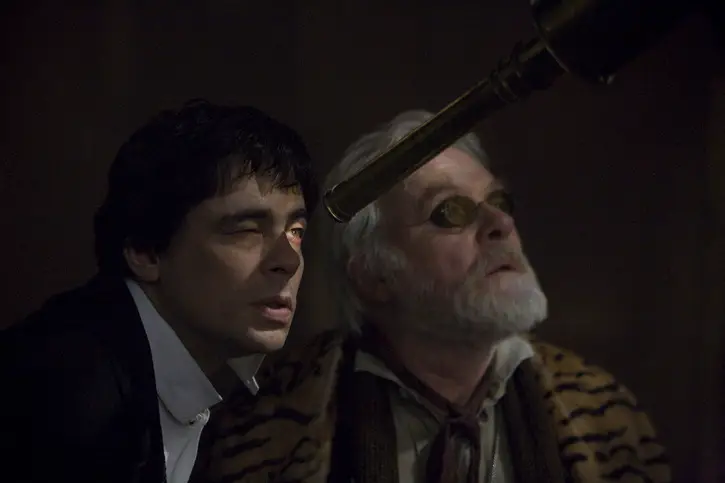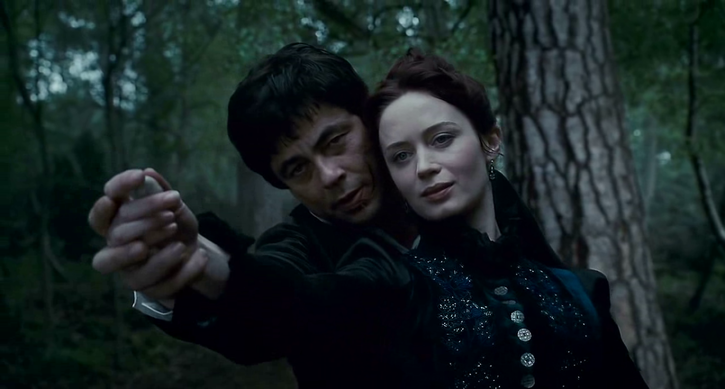“Never look back, Lawrence. Never look back. The past is a wilderness of horrors.”
Of all the Universal monsters, the Wolf-Man likely ranks the lowest. While no less tragic, he is a character that, among the pantheon of monsters, always feels like the sad sack of the bunch. Yet, occasionally, someone does a good werewolf movie, and you realize how much gothic melodrama there is to mine.
Joe Johnston’s 2010 The Wolfman is a prime example. Blending digital and practical effects, Johnston crafts a lush and atmospheric tale about cursed noblemen and a love that can never be. At its core, part of what makes The Wolfman so damn fun is how it feels ripped from the same fabric as the classic Hammer films.

Only whereas the Hammer films did a lot with a little, Johnston and his set designer Rick Heinrich made sure every nook and cranny of the frame was filled with lavish set designs and locales. Two years after Marvel’s Iron Man, the era of franchises was slowly beginning to come into being, making The Wolfman one of the last visually opulent exercises before the old town would succumb to churning out cheap, ugly, factory-assembled IP-mania.
The Wolfman feels like the last howl of a dying era. Before Sony’s ill-fated ‘Dark Universe’ and in the midst of the birthing of the Marvel universe, Johnston’s The Wolfman stands like some snarling reminder of what Hollywood excess used to look like. This makes the film’s box office failure, and the chilly reception by critics is all the more baffling.
Not that The Wolfman is all that deep, mind you, but neither are most werewolf movies. However, besides Heinrich’s lavish sets, Johnston’s secret weapon is Shelly Johnson’s camera. Johnston and Johnson light every frame with moonlight and shroud every actor in a thin veil of morose pity. Mix this with Danny Elfman’s palpating score and some of the best faces for gothic tales of the time, and you have a swooning, melancholy, gothic banger.
Benicio del Toro, Anthony Hopkins, Emily Blunt, and Hugo Weaving are the kind of actors who are tailor-made for movies like The Wolfman. Their sculpted faces are perfect for shrouding in the moonlight or revealing themselves as they step out of the shadows. Johnston and Johnson know this and have a ball with close-ups, covering them with shadows and moonlight, highlighting their cheekbones and haunted, wane smiles.
It helps that from time to time, Johnston cuts to Weaving’s Inspector Francis Aberline of Scotland Yard. A legend amongst the locals, he worked on the Ripper case, after all. He spends much of his time issuing dire warnings, listening to tall tales from locals at the tavern, or chasing the strange beast leaping through the London skyline. Weaving, like the others, knows exactly what kind of film he’s in as you can almost catch his dour glance into the distance breaking into a grin before the camera cuts away. Weaving’s Inspector Francis is the stuffed shirt that gradually becomes untucked as the film races along, and few people do it better than Weaving.
Johnston’s The Wolfman is a prime cut of sketchbook cinema. Meaning the story could fit on the back of a matchbook. That’s not to undermine what Walker and Self have cobbled together from Curt Sidomak’s story. Far from it, as they give the story enough oomph to keep us going from frame to frame but not enough to where any of it really matters. It’s the craftsmanship that makes The Wolfman such a howling delight.
Craftsmanship aided by del Toro’s magnificent visage. Del Toro embodies the doomed and tragic Lawrence Talbot. We meet him on the stage playing Hamlet. It is a nice little touch from Andrew Kevin Walker and David Self’s script, hinting at the parallels between the two tragic figures and the story of betrayal and murder yet to unfold. All of which del Toro wears nobly, with his terse line delivery and soulful glances at whoever he’s talking to, you can’t tell if he will scream in rage or cry in agony.
Walker and Self’s script has some wonderful gems, such as the monologue Hopskin’s Sir John delivers to Lawrence while in the asylum. It’s a fantastic hammy performance that never goes too broad. Mainly because Hopkins plays the mysterious and enigmatic Sir John with a smirk. Hopkins and del Toro are clearly having a good time chewing the script but never froth at the mouth about it. To say nothing of how, from time to time, the dialogue begins to broach poetry.
In large part, this could be because of Sidomak’s influence. The son of the great noir director Robert Sidomak, he, Walker, and Self understand that gothic horror and film noir overlap more than people realize. Both require people to be trapped by fate and their own desires. A perfect summary of the characters of The Wolfman, characters chained to a boat as it careens down the rapids of fate.
The one great flaw of The Wolfman and the script is how it inexcusably wastes Blunt’s Gwen. Blunt does an immaculate job playing a distressed damsel but ensures she’s never a damsel in distress. Still, Johnston and the script seem unable to view her as little else than a pawn in the games of Lawrence and Sir John. The romance that sparks between Lawrence and Gwen has a lush sense of doom to it, helped by the chemistry of Blunt and del Toro.

Johnson’s camera lights Blunt’s Gwen like a porcelain doll. Sadly, she feels more like a doll than a real flesh-and-blood character, which, considering it’s a gothic romance that requires flesh and blood, leaves the film hobbling as it barrels toward the end. The sexual tension is there but feels underutilized, almost neutered by the overt chasteness of the script despite the simmering romance driving the film.
Though there are flashes of a more breathless eroticism, despite Blunt being so obviously game, her Gwen, too often, feels like an afterthought; despite the chemistry between Blunt and del Toro, Johnston and the script never nail the obsessiveness they are so obviously trying to telegraph.
However, Johnston and Johnson nail the real draw of The Wolfman. As with all werewolf movies, the reason everyone is there is the transformation scenes. With the makeup done by legendary Rick Baker, the transformation scenes are some of the best of the modern era. Visceral, gnarly, and impossible to look away from. Possibly no face other than Ron Perlman has a mug so expressive that it shines through the layers of makeup quite like del Toro’s. Del Toro’s howls feel like that of a lost dog, hungry for companionship and solace, making them both menacing and heartbreaking.
The scene where he transforms in the asylum, with Johnson’s camera giving us wide shots and close-ups, so we see the transformation, making Baker’s effects front and center while never sacrificing the mood, is a brilliant piece of gothic cinema. The ripped limbs and spurting blood are a reminder of the film’s ‘R’ rating.
Even the computer effects seem to blend in nicely with the practical. Johnston uses digital effects for long shots of the Wolfman galloping through the countryside, leaping from rooftop to rooftop, and some other scenes. At the time, critics found the CGI distracting. But viewed with a modern lens, it feels more like disciplined restraint and cinematic playfulness.
Johnston and his writers do a splendid job cramming all the requisite tropes into the film. A tavern filled with gossipy locals? Check. A visit to a grimy and unsettling asylum? Check. Heaving chests, both men and women, as they whisper urgently to each other in the shadows? Check. Opening and closing the film with a shot of the moon? Oh, you better believe that’s a check.
Far from being a bad thing, tropes are familiar hallmarks. That The Wolfman is filled with them doesn’t make it less than, as much as it shows the love and lip-smacking delight the filmmakers took in crafting the film.
The Wolfman feels grandiose compared to the modern landscape of cheap-looking brand cinema. Its demise at the box office is a despairing portent of the next decade of film. But all that aside, and more importantly, it’s a genre film that isn’t compelled to stop every twenty seconds to remark how silly or weird this all is. A lesson more modern genre films could heed.
Images courtesy of Universal Pictures
Have strong thoughts about this piece you need to share? Or maybe there’s something else on your mind you’re wanting to talk about with fellow Fandomentals? Head on over to our Community server to join in the conversation!

